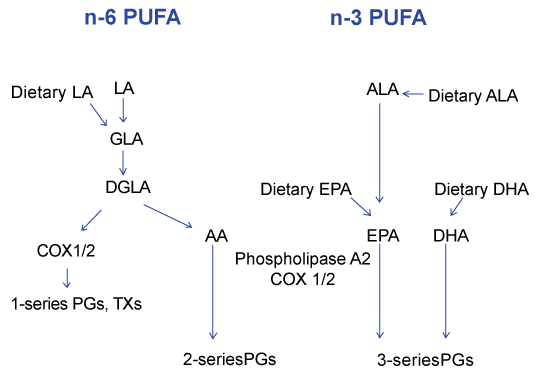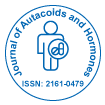Make the best use of Scientific Research and information from our 700+ peer reviewed, Open Access Journals that operates with the help of 50,000+ Editorial Board Members and esteemed reviewers and 1000+ Scientific associations in Medical, Clinical, Pharmaceutical, Engineering, Technology and Management Fields.
Meet Inspiring Speakers and Experts at our 3000+ Global Conferenceseries Events with over 600+ Conferences, 1200+ Symposiums and 1200+ Workshops on Medical, Pharma, Engineering, Science, Technology and Business
Editorial Open Access
Precursors of Pro- and Anti-inflammatory COX-2 Metabolites in Dietary Fats
| Marion M Chan1* and Dunne Fong2 | ||
| 1Department of Microbiology and Immunology, Temple University School of Medicine, Philadelphia, PA, USA | ||
| 2Department of Cell Biology and Neuroscience, Rutgers, The State University of New Jersey, Piscataway, NJ, USA | ||
| Corresponding Author : | Marion M Chan Department of Microbiology and Immunology Temple University School of Medicine 3400 North Broad Street Philadelphia, PA 19140, USA E-mail: marion.chan@temple.edu |
|
| Received May 13, 2013; Accepted May 16, 2013; Published May 19, 2013 | ||
| Citation: Chan MM, Fong D (2013) Precursors of Pro- and Anti-inflammatory COX-2 Metabolites in Dietary Fats. Autacoids 2:e122. doi: 10.4172/2161-0479.1000e122 | ||
| Copyright: © 2013 Chan MM, et al. This is an open-access article distributed under the terms of the Creative Commons Attribution License, which permits unrestricted use, distribution, and reproduction in any medium, provided the original author and source are credited. | ||
Related article at Pubmed Pubmed  Scholar Google Scholar Google |
||
Visit for more related articles at Journal of Autacoids and Hormones
| In the past two decades, many controversies developed over the detrimental impact of certain fats in processed food. For example, trans fat has given the public, the impression that most fats are bad [1,2]. Fat is necessary for blending together ingredients in food manufacturing. Nonetheless, fats are not inert. Lipids form an integral part of the cell membrane, and certain fatty acids are known to mediate cellular function. Diacylglycerol, for example, is a second messenger signaling lipid that activates protein kinase C (PKC). In fact, certain fats are “essential” nutrients. They are generally not constructed within humans by any known chemical pathways, and must be obtained from the diet [3]. There is evidence to suggest that low levels of essential fatty acids, or the wrong balance of types among the essential fatty acids, may be a factor in a number of illnesses, including arthritis, diabetes, hypertension, osteoporosis, just to name a few [4,5]. Fats serve as precursors of components for important structural, homeostatic and metabolic functions. | |
| The poly unsaturated fatty acids (PUFAs), omega-3 and omega-6, are examples of dietary fatty acids. They are known to affect the production of prostaglandins. Cyclooxygenase (COX) oxidizes the carbon-carbon double bonds (C=C) from the PUFAs, and modifies them into active compounds called eicosanoids. Depending on the PUFA, eicosanoids of the 1-series (C18), the 2-series (C20), and the 3-series (C22) are produced (Figure 1). With regard to prostaglandin (PG), there are three important isoforms: prostaglandin E-1 (PGE1), prostaglandin E-2 (PGE2) and prostaglandin E-3 (PGE3) [6-8]. | |
| PUFA intake in diet plays a part in many metabolic processes, and is known to have a significant impact on inflammatory disorders, metabolic diseases and cancer [9-11]. It is widely regarded that people on Western diet have a propensity to consume an excessive amount of omega-6 fatty acids from meats and processed food, which favors the production of a disproportionate amount of pro-inflammatory mediators. | |
| Omega-6 fatty acids, consumed in animal meats and fat, are metabolized into arachidonic acid (AA), which serves as the precursor that enhances the production of PGE2. The prostaglandin is regarded as a highly inflammatory substance with many detrimental health effects. It can cause swelling, accumulation of inflammatory cells, increased pain sensitivity, increased blood viscosity, platelet clumping, and spasm of blood vessels. Elevated PGE2 has been associated with over-reactive immune and nervous systems [3,4,12,13]. | |
| Intake of omega-3 fatty acids (C22), which include eicosapentaenoic acid (EPA), docosahexaenoic acid (DHA) and α-linolenic acid (ALA), present in nuts and cold water fish, favors the production of PGE3 [14,15]. This isomer tends to be anti-inflammatory, and is thought to counter the effects of the pro-inflammatory PGE2 [16-18]. It prevents blood platelets from clumping and helps prevent blood vessel spasm. Fatty acids important in PGE3 formation, like EPA and DHA, have been shown to reduce AA in the cells. The general recommendation for the public is to achieve a more desirable ratio of omega-6 fatty acids to omega-3 fatty acids for health promotion. | |
| Nonetheless, omega-6 fatty acids do not always produce proinflammatory AA. Dietary gamma linoleic acid (GLA), contained in safflower oil and other plant oils, increases serum dihomo-gamma linoleic acid (DGLA), without increasing serum AA. GLA can also serve as a precursor for synthesis of PG of the 1 series [19-21]. Unlike PGE2 in having 18 carbons, PGE1 has mostly been ascribed antiinflammatory properties. It attenuates inflammatory activity, and been found to attenuate inflammatory diseases in models of arthritis. It can reduce fluid accumulation, and has a significant effect on the nervous system. It has been deemed to improve depression, multiple sclerosis, premenstrual syndrome (PMS) related mood changes, schizophrenia, attention deficit hyperactivity disorder (ADHD), and other conditions [22]. | |
| Linoleic acid-rich oils from plants can also be converted, e.g. with base and heat in cooking and food processing, to conjugated linoleic acid (CLA), a dietary molecule naturally produced by ruminants and found in dairy products. CLA modulates immune response with an anti-inflammatory propendency [23,24]. CLA affects body composition by increasing body protein and decreasing body fat. It inhibits chemically induced cancer in skin, stomach, mammary and colon of rodents, and inhibits cholesterol-induced atherosclerosis. It is a ligand that activates the master “off” switch of inflammation, peroxisome proliferator activated receptor (PPAR) [25]. This family of nuclear receptors and transcription factors are found in many tissues. They play roles in insulin sensitivity, lipid metabolism in liver and muscle, and differentiation of macrophages and adipocytes. PPAR ligands are used to improve blood glucose in the treatment of Type 2 diabetes. Their activation has also been associated with suppression of inflammation and immune reactions. | |
| In conclusion, there is not an explicit answer as to whether omerga-3 is good or omega-6 is bad, and whether dietary intake of food oil enriched for selected PUFA will lead to amelioration of inflammatory diseases. Which oil or fat is best for human consumption is a complex issue that can be subjected to considerable and various interpretations. Evaluate whether dietary intake of selected PUFA or food oil (e.g. EPA and LA) promotes the production of anti-inflammatory effect, needs to be more thoroughly investigated. | |
| References | |
|
|
Tables and Figures at a glance
 |
| Figure 1 |
Post your comment
Relevant Topics
Recommended Journals
Article Tools
Article Usage
- Total views: 14203
- [From(publication date):
May-2013 - Apr 04, 2025] - Breakdown by view type
- HTML page views : 9547
- PDF downloads : 4656
